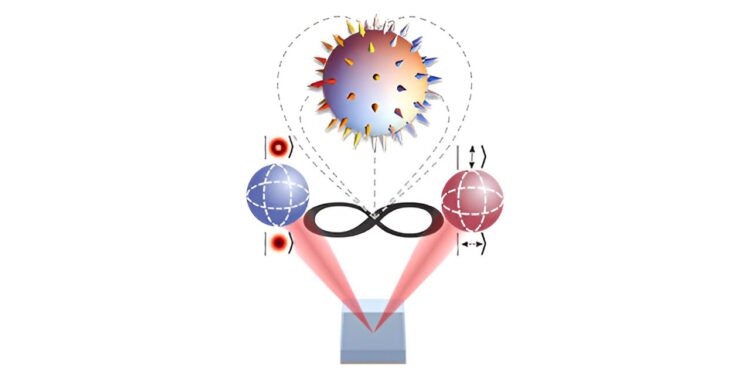Conceptual illustration of the entangled Skyrmion topology. Each photon contributes to the emerging topology which exists only as a combined entity of the two photons. Credit: Wits University
For the first time, researchers have demonstrated the remarkable ability to perturb pairs of spatially separated but interconnected quantum entangled particles without altering their shared properties.
The team includes researchers from the Structured Light Laboratory (School of Physics) at the University of the Witwatersrand in South Africa, led by Professor Andrew Forbes, in collaboration with string theorist Robert de Mello Koch from the University of Huzhou in China (formerly of Wits University).
“We achieved this experimental step by entangling two identical photons and tailoring their shared wave function such that their topology or structure only becomes apparent when the photons are treated as a unified entity,” explains the lead author. , Pedro Ornelas, holds a master’s degree in science. student in the structured light laboratory.
This connection between photons was established by quantum entanglement, often called “spooky action at a distance,” allowing particles to influence each other’s measurement results even when separated by significant distances. The research was published in Natural photonics on January 8, 2024.
The role of topology and its ability to preserve properties, in this work, can be compared to how a coffee cup can be transformed into a donut shape; despite changes in appearance and shape during transformation, a singular hole, a topological feature, remains constant and unchanged. In this way, the two objects are topologically equivalent. “The entanglement between our photons is malleable, like clay in the hands of a potter, but during the molding process, certain characteristics are retained,” explains Forbes.
The nature of the topology studied here, called Skyrmion topology, was initially explored by Tony Skyrme in the 1980s as field configurations with particle-like characteristics. In this context, topology refers to a global property of fields, similar to a piece of fabric (the wave function) whose texture (the topology) remains unchanged regardless of the direction in which it is pushed.
These concepts have since been realized in modern magnetic materials, liquid crystals and even as optical analogues using conventional laser beams. In the field of condensed matter physics, skyrmions are highly valued for their stability and noise resistance, leading to revolutionary advances in high-density data storage devices. “We aspire to see a similar transformative impact with our quantum entangled skyrmions,” says Forbes.
Previous research has described these Skyrmions as localized to a single location. “Our work presents a paradigm shift: topology traditionally thought to exist in a single, local configuration is now nonlocal, or shared between spatially separated entities,” says Ornelas.
In developing this concept, researchers use topology as a framework to classify or distinguish entangled states. They envision that “this new perspective could serve as a labeling system for entangled states, similar to an alphabet,” says co-investigator Dr. Isaac Nape.
“In the same way that spheres, donuts and handcuffs are distinguished by the number of holes they contain, our quantum skyrmions can be differentiated in the same way by their topological aspects,” says Nape. The team hopes this could become a powerful tool paving the way for new quantum communication protocols using topology as an alphabet for processing quantum information through entanglement-based channels.
The results reported in the paper are crucial because researchers have struggled for decades to develop techniques to preserve entangled states. The fact that the topology remains intact even when entanglement decays suggests a new coding mechanism that uses entanglement even in scenarios with minimal entanglement where traditional coding protocols would fail.
“We will focus our research efforts on defining these new protocols and expanding the landscape of nonlocal topological quantum states,” says Forbes.
More information:
Pedro Ornelas et al, Nonlocal Skyrmions as Topologically Resilient Quantum Entangled Light States, Natural photonics (2024). DOI: 10.1038/s41566-023-01360-4
Provided by Wits University
Quote: Researchers demonstrate that quantum entanglement and topology are inextricably linked (January 8, 2024) retrieved January 9, 2024 from
This document is subject to copyright. Apart from fair use for private study or research purposes, no part may be reproduced without written permission. The content is provided for information only.



